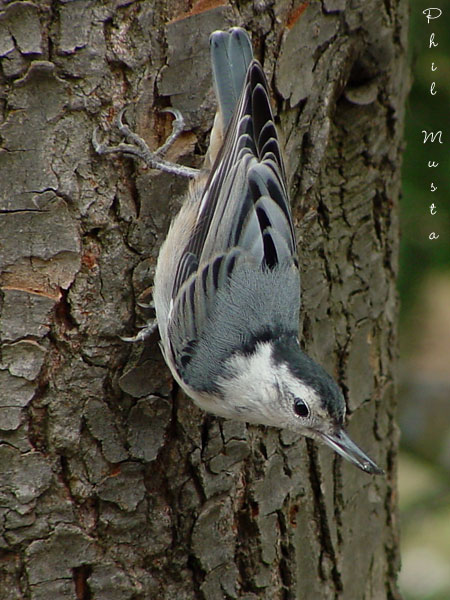- Sitta carolinensis
Identification
Length 15·5 cm (6 in)
- Blue-grey above
- White underparts and face
- Black crown
Variation
Three forms should be distinguishable in the field: slender-billed (Pacific), Rocky Mountain, and Carolina (Eastern half of the continent). See post 58 in this Birdforum thread[4].
Distribution
Largely resident from British Columbia, Ontario, and Nova Scotia south to southern California, Arizona, Gulf Coast, and central Florida. Absent from most of Great Plains.
Taxonomy
A recent paper proposes that the White-breasted Nuthatch should be split into 4 species corresponding to the areas The Pacific, The East, ESNNR [Eastern Sierra Nevada and Northern Rockies] and RGM [Rocky Mountain, Great Basin and Mexico][4].
Subspecies
Nine subspecies are recognized[1]:
- S. c. carolinensis - North-eastern North America to Dakotas, Kansas, Oklahoma and eastern Texas
- S. c. nelsoni - Rocky Mountains of western US to northern Mexico (Sonora and northern Chihuahua)
- S. c. oberholseri - South-western Texas (Chisos Mountains) to eastern Mexico (northern Sierra Madre Oriental)
- S. c. mexicana - Mountains of western Mexico (Sierra Madre Occidental)
- S. c. kinneari - Mountains of western Mexico (Guerrero and Oaxaca)
- S. c. tenuissima -British Columbia and Cascades to the east slope of the Sierra Nevada of northern California (south to Tulare County)
- S. c. aculeata -western Washington to western Oregon (east to the west slope of the Cascades), California (east to the west slope of the Sierra Nevada), and northern Baja California (Sierra Juárez)
- S. c. alexandrae -Mountains of northern Baja California (San Pedro Mártir)
- S. c. lagunae Mountains of southern Baja California (Sierra de la Laguna)
Three additional subspecies, atkinsi, umbrosa and cookei[2], are not recognised by all authorities.
Habitat
Deciduous and mixed forests, also coniferous.
Behaviour
Usually seen creeping on tree trunks, head downward
Breeding
Five to six white eggs, lightly speckled with red-brown, are laid in a cup of twigs and grass lined with feathers and hair. The nest site is in a natural cavity, bird box, or hole excavated by the birds.
Diet
They have a varied diet of insects, seeds, acorns and nuts and are known to stores food behind loose bark for use during the winter. Commonly seen at bird feeders.
Vocalisation
Call: A nasal yank-yank.
Song: A series of low whistled notes.
References
- Clements, J. F., T. S. Schulenberg, M. J. Iliff, S. M. Billerman, T. A. Fredericks, B. L. Sullivan, and C. L. Wood. 2019. The eBird/Clements Checklist of Birds of the World: v2019. Downloaded from http://www.birds.cornell.edu/clementschecklist/download/
- Birdforum thread (especially from post29) discussing taxonomy of this species
Recommended Citation
- BirdForum Opus contributors. (2024) White-breasted Nuthatch. In: BirdForum, the forum for wild birds and birding. Retrieved 5 May 2024 from https://www.birdforum.net/opus/White-breasted_Nuthatch
External Links





